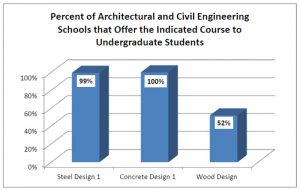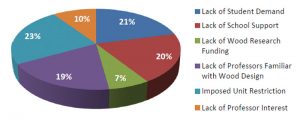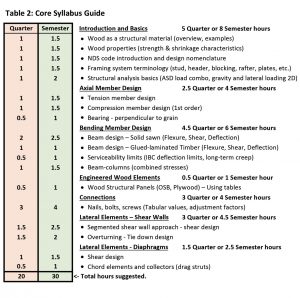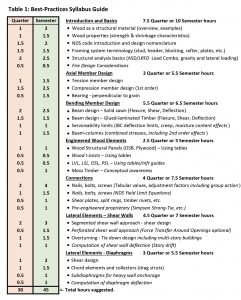An Analysis of Current Wood Engineering Education in U.S. Universities
Structural engineers are becoming aware of the impact the selection of structural materials can have on the environment. The building industry is acknowledging and embracing the contribution of the sustainable potential of wood to reduce the environmental footprint of a project through its carbon-storing capabilities and renewable qualities.
Relevant was the introduction of cross-laminated timber (CLT) into the 2015 International Building Code (IBC) and the creation of the International Code Council’s (ICC) Tall Wood Building Ad Hoc Committee. The Committee investigated the viability of increasing allowable areas and heights of mass timber construction, which resulted in code changes for the 2021 IBC to provide for allowable story heights of mass timber to 9, 12, and 18 stories depending on assembly fire ratings, occupancy, and other safety requirements.
With its use in most residential construction, wood is already a highly common construction material in the U.S. The need to embrace sustainability, will expand wood design and construction into new sectors in the future. The rise of tall and large-scale mass timber construction will require more engineered and performance-based design approaches than currently practiced. Are students in the U.S. adequately prepared by their higher education institutions and degree programs to meet these new demands?
The Current State of Wood Engineering Education

Figure 1. Percent of architectural and civil engineering schools that offer the indicated course to undergraduate students.
To fully realize the potential of wood used as a structural material in modern buildings, there first needs to be a data-based understanding of the current status of wood engineering education in our existing higher education systems. The National Council of Structural Engineers Associations (NCSEA) surveyed, in 2019, higher education institutions that offer accredited civil engineering and architectural engineering programs on their inclusion of timber design class materials in undergraduate curricula. With two-thirds responding, preliminary observations made through this independent survey confirm that, while nearly 100% of the surveyed U.S. universities offer steel and concrete design courses, only 52% offer a wood design course to undergraduates (Figure 1). Of those universities that do offer a wood design course, it is often only available biennially or triennially, typically only listed as an elective or cross-listed as a dual graduate/undergraduate course. Past NCSEA structural engineering curriculum surveys also indicate that universities often combine wood and masonry design into a single course, even though the design methodology and mechanics are significantly different for these two materials. As a direct result, approximately half of civil, structural, and architectural engineering students graduating from U.S. schools may have either no exposure or very limited exposure to the proper application of wood as a structural material. This absence of foundational knowledge from their education will result in either avoidance or improper and/or ineffective use of wood when these students enter the structural engineering workforce.
With this evident lack of wood engineering coverage in the U.S. higher education curriculum, potential reasons for this deficiency were also surveyed, and the results reveal that there are many contributors to the lack of availability of wood courses (Figure 2). The leading reasons include the limit on program credit hours, lack of school support, and lack of student demand. Lack of professors who are familiar with wood design and research is also listed as a significant factor. In fact, among the schools that offer wood design, a good portion of the programs use part-time adjunct teachers to cover that class due to the lack of full-time faculty with wood design experience. The limit on credit hours is deeply rooted in how a 4-year engineering program operates. For the program to be competitive and viable in 4 years, most of the engineering programs limit their total required semester credit hours to around 120 to 135, thus discouraging additional courses. Also, the accreditation process of the degree program (ABET) only requires the ability to conduct engineering design without explicitly requiring the inclusion of any particular material. These conditions inevitably result in choosing steel or concrete design as the required design class, while leaving wood out entirely or just listing it as an elective class. The consequences of these gaps in classroom instruction result in students with engineering degrees lacking the skills to research, design, and build with wood. It limits innovation in wood design and reduces the likelihood of wood use in construction and infrastructure development.
But there is also hope that the current mass timber movement will set in motion a renewed interest in innovative wood architecture. Although the mass timber market itself is still in an early development stage, signature projects in the U.S. and around the world have already started to positively impact people’s perception about building with wood. Student demands have been rising in many schools in the U.S. There is a timely opportunity for the wood industry to partner with educators to develop a strategic focus on wood engineering education in undergraduate civil, structural, and architectural engineering programs in the United States.
Wood Education Symposium
Recognizing significant changes in modern wood construction due to the development of new modern materials and manufacturing techniques, the ASCE/SEI Wood Education Committee (WEC) is actively working on multiple projects with the ultimate goal of updating wood education in the U.S. to cope with these exciting new developments.
To that end, the WEC organized a full-day wood education symposium at the annual ASCE/SEI April 2017 Structures Congress in Denver, Colorado. Collaborative partnerships were established to assemble key wood construction influencers from academia, engineering, and industry to participate in the symposium. To establish a foundation for this effort that was inclusive of all the stakeholders, for the first time, a partnership was formed between the WEC representing the academic sector, the National Council of Structural Engineers Association (NCSEA) Basic Education Committee (BEC) representing the structural engineering profession, and American Wood Council (AWC) representing the wood industry. Symposium participants placed a strong emphasis on developing a recommended wood design curriculum that can be used at undergraduate and graduate levels. An additional high priority was the development of a strategic plan that would help the industry better understand current gaps and assist in addressing needs for the adoption of wood courses by architectural and civil engineering programs around the country, especially those currently lacking them.
As a result of the symposium, four main issues were identified for current wood education. Participants also developed priorities for actions that can be taken to help resolve these issues.
Key Wood Engineering Education Issues
As a result of the symposium, four main issues were identified for current wood education. Participants also developed priorities for actions that can be taken to help resolve these issues.
- Current Civil Engineering programs consider steel and concrete design as core courses while wood design is treated as either unnecessary or optional, and graduate programs most often are entirely devoid of wood related education.
- There is a lack of faculty with knowledge of wood engineering. While almost every structural engineering department is able to teach steel and concrete, wood is usually taught by part-time or adjunct faculty, often resulting in a lack of rigor and focus on wood engineering fundamentals.
- There is a disproportionally more significant amount of steel and concrete research at major universities as compared to wood, and a majority of Ph.D. students (future faculty) have no exposure to wood-related research.
- There is currently no established mechanism for reciprocity of courses between universities.
The proposed strategy to improve wood engineering education was designed to address these significant issues comprehensively. Critical components of what is needed to support success are Educational Materials, Curriculum Definition, Widespread Adoption, Comprehensive Materials Science Education, Accessible Information, Education Beyond the Classroom, and Leadership in Advanced Degrees.
The ASCE/SEI WEC, NCSEA-BEC, and AWC continued to work together after the symposium to develop a strategic plan in tandem with implementing two key elements:
- A crucial part of this expansion involves new and seasoned educators continuing to develop their wood design courses online, with input from other educators and engineering practitioners.
- ASCE’s Wood Education Committee decided upon the development of a syllabus template based on input from engineering practitioners and academics currently fluent in wood engineering.
A copy of the Wood Education Symposium report may be found at asce.org by searching “wood education.”
Syllabus Guideline Templates
The Wood Education Committee began its development of syllabus templates by assembling a subcommittee of WEC members, balancing university academic experience with engineering practice experience. This effort intends to provide a standard reference to any educators who are interested in teaching wood in their program. Following a three-step process, two syllabus templates were developed: one of minimum core material for a university course in the engineering design of wood structures and another for a course striving to meet best-practices.
The Committee’s first step was assembling a list of potential topics within a wood engineering course. Secondly, the list of topics was grouped into those necessary for a minimum core program, those recommended for the best-practices achievement, those best reserved for a graduate-level course, and other topics best covered in a separate engineering support course.
For undergraduate education, the Committee then focused on topics for minimum-core and best-practices categories. Based on committee member experiences, the suitable number of hours of classroom instruction was recommended for each of the topics for both semester and quarter systems. The results of that effort are presented in Table 1 and Table 2. In Table 2, topics in italics are unique to the best-practices syllabus guideline.
The intent of the minimum-core template is for professors, who are unfamiliar with wood and looking for a place to start, to utilize it as a baseline for their course. Then, as they gradually prepare and develop their course over several terms, they could add content from the best-practices template with each iteration. Alternatively, the core syllabus guideline has been provided with reduced classroom hours to address the situation where wood design contents were combined with another course such as structural analysis, wind and seismic design, or masonry design.
When comparing the core guideline with the best-practices approach, it can be observed that the WEC thought some topics would derive little benefit with additional hours in a best-practices situation, while other topics would benefit from additional time. Moreover, best-practices provide new topics identified by practicing engineers as important.
The best-practices template should be a goal for those striving to offer a course that will devote all credit hours to wood engineering. The list of hours for both quarter and semester terms provides instructors guidance as to how to pace their course under different school calendar arrangements.
Working to Fill the Void
Meeting the building construction industry’s demand for university undergraduates with education in wood engineering requires university programs and faculty to be familiar with wood as a modern construction material. It will likely be a long process considering the current state of higher education on wood design. It will not be easy when many faculty members do not have any wood engineering education, perpetuating the cycle. Hopefully, the syllabus guideline templates and subsequent efforts by ASCE/SEI WEC and NCSEA BEC will serve as initial steps to help break this cycle by providing easy access to educational information in this exciting field. The Committees continue to work together to create opportunities for wood engineering courses and to develop educational resources for those interested in teaching it so that graduating students will be better prepared for this changing building industry.■



